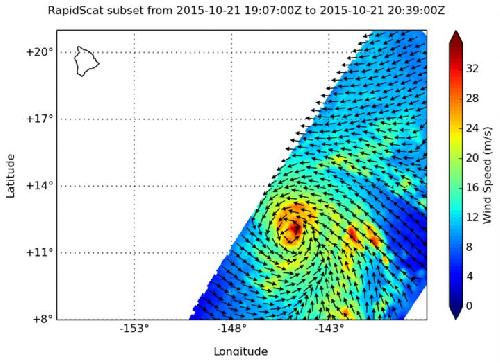The RapidScat instrument aboard the International Space Station analyzed Hurricane Olaf's winds in the Central Pacific Ocean.
RapidScat gathered wind speed and direction data on Olaf on Oct. 21 at 2000 UTC (8 p.m. EDT). RapidScat measured sustained winds around the center at more than 36 meters per second/70 knots/80.5 mph/129.6 kph). Hurricane force winds extend outward up to 30 miles (45 km) from the center and tropical storm force winds extend outward up to 155 miles (250 km).
RapidScat measures wind speed at the surface which is always lower than speeds at higher altitude. There is an upper limit on RapidScat of 50 meters/second (111 mph/180 kph) and Olaf still exceeded that limit.
 RapidScat gathered wind speed and direction data on Olaf on Oct. 21 at 2000 UTC (8 p.m. EDT). RapidScat measured sustained winds around the center at more than 36 meters per second/70 knots/80.5 mph/ 129.6 kph). Credit: Credits: NASA JPL, Doug Tyler
RapidScat gathered wind speed and direction data on Olaf on Oct. 21 at 2000 UTC (8 p.m. EDT). RapidScat measured sustained winds around the center at more than 36 meters per second/70 knots/80.5 mph/ 129.6 kph). Credit: Credits: NASA JPL, Doug Tyler
At 11 a.m. EDT (5 a.m. HST/1500 UTC) on Oct. 22, the center of Hurricane Olaf was located near latitude 13.5 degrees north and longitude 146.3 degrees west. That's about 720 miles (1,165 km) southeast of Hilo, Hawaii. Olaf was moving toward the northwest near 7 mph (11 kph) and NOAA's Central Pacific Hurricane Center expects a gradual turn toward the north-northwest tonight. Olaf is forecast to move slowly northward Friday and Friday night (October 23).
Maximum sustained winds are near 115 mph (185 kph). Olaf is a category three hurricane on the Saffir-Simpson Hurricane wind scale. Little change in intensity is expected today and weaken later on October 22 and 23.
Swells generated by Hurricane Olaf will produce life-threatening and potentially damaging surf along east facing shores of the Hawaiian Islands into the weekend of October 24 and 25.
source: NASA/Goddard Space Flight Center